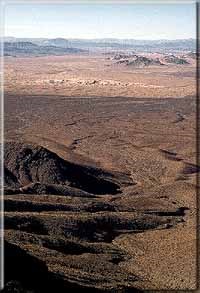
Roger Taguchi Three of the four major North American deserts are found at Mojave National Preserve: the Mojave, Great Basin and Sonoran. Dozens of seeps and springs coupled with varied elevations and soil types create microhabitats that support a diversity of plant and animal life. Cactus gardens, relict plant communities of white fir and chaparral and the densest, largest Joshua tree forest are all found here. Temperatures vary considerably along with the great range in elevation, from 7,929 feet at Clark Mountain to 880 feet near Baker. Summer temperatures average from 90 to upwards of 105 degrees, while lows in the winter can plummet to the 20's and blanket the Mojave with snow. As elevations effect temperatures, so too does it influence precipitation. Mountain areas receive around 9 inches annually, while lower lying areas near Baker average only 3.37 inches. At least 25 percent of precipitation falls in localized summer monsoon thunderstorms. 
(D. Schramm) Much of Mojave National Preserve appears to be barren, nearly lifeless. Signs of animal life are subtle and easily overlooked. Closer investigation reveals that the desert is home to many animals. Birds and lizards are seen most frequently, but time of day, weather, and season all play a role in determining which animals are active. Desert animals must survive in brutal heat with light vegetative cover. They are supremely adapted to manage the temperature and moisture stresses. A large percentage of desert animals are nocturnal, or active at night, allowing them to evade higher temperatures and predators. Nocturnal animals include most desert rodents, bats, owls, mountain lion, skunks, and foxes. Other animals are crepuscular, active at dawn and dusk. Diurnal animals, active during the day, are the most dynamic in that their activity periods change based on temperature and season. 
USGS Las Vegas Mojave National Preserve is a wonderful place to explore and learn about geology.The USGS website features a gallery of rock features here. Science NewsletterLearn More about Preserve Science!Science Newsletters are in collaboration between Mojave National Preserve and Sweeney Granite Mountains Dsert Research Center. |
Last updated: January 3, 2022
